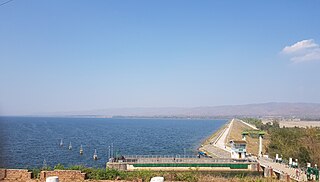Sinohydro is a Chinese state-owned hydropower engineering and construction company. In the 2012 Engineering News-Record Top 225 Global Contractors, a ranking by annual revenue, the company is 14th by overall position, and 6th among Chinese construction companies.

There are almost 200 large dams in Myanmar. Myanmar (Burma) has a large hydroelectric power potential of 39,000 megawatts (52,000,000 hp), although the economical exploitable potential is about 37,000 megawatts (50,000,000 hp). Between 1990 and 2002, the country tripled its installed capacity of hydro plants, increasing from 253 megawatts (339,000 hp) to 745 megawatts (999,000 hp). Total installed capacity in 2010 is at least 2,449 megawatts (3,284,000 hp) MW, 6% of potential. Several large dams are planned to increase future hydro utilization.
The Rusumo Hydroelectric Power Station, also known as the Rusumo Power Station, is a hydropower plant under construction, with initial planned capacity installation of 80 megawatts (110,000 hp) when completed. The project will involve the construction of a dam, with run of river design. A more expensive 90 megawatts (120,000 hp) reservoir design was considered before being abandoned in favor of an 80 MW project with a smaller environmental impact and an estimated cost of US$300 million compared to US$400 million for the bigger project. The World Bank announced on 6 August 2013 that it had approved loans totaling US$340 million towards the US$468.60 million needed for the project. In November 2013, the African Development Bank approved a loan of US$113 million towards completion of the project.

Renewable energy in Nepal is a sector that is rapidly developing in Nepal. While Nepal mainly relies on burning biomass for its energy needs, solar and wind power is being seen as an important supplement to solve its energy crisis. The most common form of renewable energy in Nepal is hydroelectricity.

The Broadlands Dam is a 35 MW run-of-the-river hydroelectric complex currently under construction in Kitulgala, Sri Lanka. The project is expected to be completed in 2020, and will consist of two dams, and a power station further downstream.
Nepal Electricity Authority (NEA), founded on 16 August 1985, is the parent generator and distributor of electric power under the supervision of the government of Nepal.
Panauti Hydropower Station is the third hydropower station which was constructed in Nepal, in 1965. It is the first megawatt (MW) capacity hydropower station in Nepal.

The Kulekhani Dam is a rock-fill dam on the Kulekhani River near Kulekhani in the Indrasarowar Rural Municipality of Makwanpur District in Bagmati Province, Nepal. The primary purpose of the dam is hydroelectric power generation and it supports the 60 MW Kulekhani I and 32 MW Kulekhani II Hydropower Stations. Construction began in 1977 and Kulekhani I was commissioned in 1982. Kulekhani II was commissioned in 1986 and a third power station, the 14 MW Kulekhani III was expected to be commissioned in May 2015 but was delayed due to issues with the builder. The US$117.84 million project received funding from the World Bank, Kuwait Fund, UNDP, Overseas Economic Cooperation Fund and OPEC Fund. It is owned by Nepal Electricity Authority.
Nenskra Hydro Power Plant is a proposed hydroelectric power station to be located on the southern slopes of the Central Caucasus mountains in Svaneti, Georgia.
The Budhi Gandaki Hydroelectric Project is a proposed hydroelectric power plant in Nepal, to be developed by Nepal Electricity Authority (NEA).
The Moragolla Dam is a planned hydroelectric dam in Moragolla, Sri Lanka. The dam is to be 35 m (115 ft) high and is planned to create the 1,980,000 m3 (70,000,000 cu ft) Moragolla Reservoir with a maximum supply level at 548 m (1,798 ft) MSL. Upon completion, the Moragolla Power Station would have a gross installed capacity of 30 megawatts from two francis turbines, capable of generating approximately 85 GWh annually.

The Tamakoshi River is part of the Koshi or Sapta Koshi river system in Nepalese Himalayas. It originates from Rongshar Chu and Lapchi Gang rivers close to the Nepal-Tibet border. It flows in southern direction through Bagmati Province in Nepal, namely through Dolakha District and Ramechhap District.
Nuwakot Solar Power Station is located at Nuwakot District of Nepal. It is the largest solar power plant of Nepal. The plant is owned by Nepal Electricity Authority (NEA). The solar panels are installed in six locations within the premises of Devighat Hydropower Station which is also owned by the NEA. Energy generated by the project is connected to the 66 kV sub-station of Devighat Hydropower Station. The solar station generates energy only during the daytime.
Sipring Khola Hydropower Station is a run-of-river hydro-electric plant located in Dolakha District of Nepal. The flow from Sipring River, a tributary of Tamakoshi River, is used to generate 10 MW electricity. The design head is 443.7 m and the design flow is 2.61m3/s.
Kabeli B1 Hydropower Station is a 25 MW run-of-river hydro-electric plant located in Panchthar District of Nepal. The promoter and operator, with a 20% share, is Arun Kabeli Power Limited (AKPL), a subsidiary of Arun Valley Group.
Rudi A Hydropower Station is a run-of-river hydro-electric plant located in the Kaski District of Nepal that came into operation in 2019. The flow from the Rudi River is used to generate 8.8 MW electricity.

The Golyan Group is a Nepalese corporate business enterprise that has been operating in Nepal for over six decades. The group has diversified investments in various business verticals, including manufacturing, agriculture, tourism, real estate, financial services, and renewable energy.









